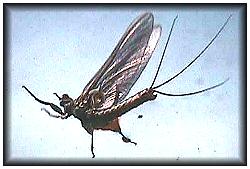The question is always first. Why do nymphs that
are colored essentially the same end up being tied by almost
everyone in similar but different colors. Blue winged olives are tied green,
but the natural isn't green as portrayed in any book I have seen.
Dortheas and pale morning duns are tied yellow, but photographs
of the naturals show them brown. Hendricksons are tied reddish
but the natural is brown. When sharp people are asked the common
answer is, "because they work." Still that doesn't answer the
question of, "why do they work?"
Trout, in the normal course of their
existence, must during any hatch have at least several
search patterns present. One for each stage of the insects
life cycle, and also in some cases a pattern for the insects
eggs. That is three to four search patterns that are present
and used every day. These patterns are not even similar.
Each day it is the same cycle. Nymph, dun, emerger,
spinner and egg.
In a search pattern the more components
that are stimulated the more likely the trout is to eat the insect.
Now comes the tale. Instead of matching just one search pattern
the trick is to add things from as many of the search patterns
present as possible so as to have an "unbeatable imitation." Add
the distinctive color of the dun to the nymph search pattern for
the blue winged olive, but not so green as to scare the fish. At
that time you have stimulated two search patterns. With a little
thought a nymph should have something from all three or four
food groups.

Major factors such as size and general
appearance won't transfer. They will just diminish the dominant
search pattern. It is really a building thing. Start with the basic
search pattern and add what you can. The color of the spinner
in the Hendrickson, the color of the dun in the blue winged olive
and the pale morning dun. The color of the dun in the Dorthea
hatch and also the shine of the duns wings.
In order to be a successful designer a
fly-fisher has to understand what is involved in each trout
search pattern and be able to steal a little from each part of
the cycle to arrive at a nymph that will tickle each pattern a
little without diminishing the main pattern. Color seems to
transfer easily between search patterns. I would guess that
the sharp observer would find other transfers I've missed.
The key seems to be to augment the main pattern without
diminishing it.
I have also noticed that adjacent hatches
of radically different size are susceptible to the color transfer
of the dominant pattern of the previous hatch. Early on in a
hatch a fly representating the dun as to size with the color of
the previous hatch can be a killer. Even if the sizes of the naturals
are different. The artificial steals from two different search
patterns. One plus one equals three if you can pick up enough
from the previous hatch.
Since there are always multiple search patterns
present in the trout brain the sharp tier would try to access positive
aspects of several hatches and incorporate them into the final product
along with the always present search keys like motion, legs and so on.
Many of our most popular flies owe their success to the fact that they
have stolen key aspects of several hatches.
Tie those flies with the dominant
color of the hatch. Then as Micky Dee says, "super size it," or
more to the point, enhance the color so as to drag everything you
can from the color act.~ "Old Rupe"
|

